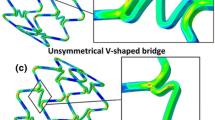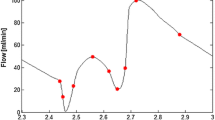Abstract
Many clinical studies, including the ISAR-STEREO trial, have identified stent strut thickness as an independent predictor of in-stent restenosis where thinner struts result in lower restenosis than thicker struts. The aim of this study was to more conclusively identify the mechanical stimulus for in-stent restenosis using results from such clinical trials as the ISAR-STEREO trial. The mechanical environment in arteries stented with thin and thicker strut stents was investigated using numerical modelling techniques. Finite element models of the stents used in the ISAR-STEREO clinical trial were developed and the stents were deployed in idealised stenosed vessel geometries in order to compare the mechanical environment of the vessel for each stent. The stresses induced within the stented vessels by these stents were compared to determine the level of vascular injury caused to the artery by the stents with different strut thickness. The study found that when both stents were expanded to achieve the same initial maximum stent diameter that the thinner strut stent recoiled to a greater extent resulting in lower luminal gain but also lower stresses in the vessel wall, which is hypothesised to be responsible for the lower restenosis outcome. This study supports the hypothesis that arteries develop restenosis in response to injury, where high vessel stresses are a good measure of that injury. This study points to a critical stress level in arteries, above which an aggressive healing response leads to in-stent restenosis in stented vessels. Stents can be designed to reduce stresses in this range in arteries using preclinical tools such as numerical modelling.





Similar content being viewed by others
References
Bedoya J, Meyer CA, Timmins LH, Moreno MR, Moore JE Jr (2006) Effects of stent design parameters on normal artery wall mechanics. J Biomech Eng 128:757–765
Briguori C, Sarais C, Pagnotta P et al (2002) In-stent restenosis in small coronary arteries: impact of strut thickness. J Am Coll Cardiol 40:403–409. doi:10.1016/S0735-1097(02)01989-7
de Quadros AS, Sarmento-Leite R, Gottschall CA, Silva GV, Perin EC (2006) Hyperexpansion of coronary stents and clinical outcomes. Tex Heart Inst J 33:437–444
Duraiswamy N, Schoephoerster RT, Moreno MR, Moore JE Jr (2007) Stented artery flow patterns and their effects on the artery wall. Annu Rev Fluid Mech 39:357–382. doi:10.1146/annurev.fluid.39.050905.110300
Early M, Lally C, Prendergast PJ, Kelly DJ (2008) Stresses in peripheral arteries following stent placement: a finite element analysis. Comput Methods Biomech Biomed Engin (in press)
Fischman DL, Leon MB, Baim DS (1994) A randomized comparison of coronary-stent implantation with balloon angioplasty in patients with coronary artery disease. N Engl J Med 331:496–501. doi:10.1056/NEJM199408253310802
Grewe PH, Deneke T, Machraoui A, Barmeyer J, Muller K-M (2000) Acute and chronic tissue response to coronary stent implantation: pathologic findings in human specimens. J Am Coll Cardiol 35:157–163. doi:10.1016/S0735-1097(99)00486-6
Hara H, Nakamura M, Palmaz JC, Schwartz RS (2006) Role of stent design and coatings on restenosis and thrombosis. Adv Drug Deliv Rev 58:377–386. doi:10.1016/j.addr.2006.01.022
Holzapfel GA, Stadler M, Gasser TC (2005) Changes in the mechanical environment of stenotic arteries during interaction with stents: computational assessment of parametric stent designs. J Biomech Eng 127:166–180
Holzapfel GA, Sommer G, Gasser CT, Regitnig P (2005) Determination of layer-specific mechanical properties of human coronary arteries with nonatherosclerotic intimal thickening and related constitutive modeling. Am J Physiol Heart Circ Physiol 289:H2048–H2058. doi:10.1152/ajpheart.00934.2004
Hwang C-W, Wu D, Edelman ER (2001) Physiological transport forces govern drug distribution for stent-based delivery. Circulation 104:600–605. doi:10.1161/hc3101.092214
Kastrati A, Mehilli J, Dirschinger J et al (2001) intracoronary stenting and angiographic results: strut thickness effect on restenosis outcome (ISAR-STEREO) trial. Circulation 103:2816–2821
Kim J, Kang Y-H, Choi H-H, Hwang S-M, Kang B-S (2002) Comparison of implicit and explicit finite-element methods for the hydroforming process of an automobile lower arm. Int J Adv Manuf Technol 20:407–413. doi:10.1007/s001700200170
Lally C, Dolan F, Prendergast PJ (2005) Cardiovascular stent design and vessel stresses: a finite element analysis. J Biomech 38:1574–1581. doi:10.1016/j.jbiomech.2004.07.022
Liang DK, Yang DZ, Qi M, Wang WQ (2005) Finite element analysis of the implantation of a balloon-expandable stent in a stenosed artery. Int J Cardiol 104:314–318. doi:10.1016/j.ijcard.2004.12.033
Loree HM, Grodzinsky AJ, Park SY, Gibson LJ, Lee RT (1994) Static circumferential tangential modulus of human atherosclerotic tissue. J Biomech 27:195–204. doi:10.1016/0021-9290(94)90209-7
McClean R, Eigler NL (2002) Stent design: implications for restenosis. Rev Cardiovasc Med 3:S16–S22. doi:10.1016/S1522-1865(02)00137-3
Migliavacca F, Petrini L, Colombo M, Auricchio F, Pietrabissa R (2002) Mechanical behavior of coronary stents investigated through the finite element method. J Biomech 35:803–811. doi:10.1016/S0021-9290(02)00033-7
Morrow D, Sweeney C, Birney YA et al (2005) Cyclic strain inhibits notch receptor signaling in vascular smooth muscle cells in vitro. Circ Res 96:567–575. doi:10.1161/01.RES.0000159182.98874.43
Morton AC, Crossman D, Gunn J (2004) The influence of physical stent parameters upon restenosis. Pathol Biol 52:196–205. doi:10.1016/j.patbio.2004.03.013
Murphy BP, Savage P, McHugh PE, Quinn DF (2003) The stress–strain behaviour of coronary stent struts is size dependent. Ann Biomed Eng 31:686–691. doi:10.1114/1.1569268
Ogden RW (1972) Large deformation isotropic elasticity: on the correlation of theory and experiment for incompressible rubberlike solids. Proc R Soc Lond A Math Phys Sci 326:565–584. doi:10.1098/rspa.1972.0026
Pache J, Kastrati A, Mehilli J et al (2003) Intracoronary stenting and angiographic results: strut thickness effect on restenosis outcome (ISAR-STEREO-2) trial. J Am Coll Cardiol 41:1283–1288. doi:10.1016/S0735-1097(03)00119-0
Serruys PW, Kutryk MJB (1998) Handbook of coronary stents, 2nd edn. Martin Dunitz Ltd, London
Serruys PW, Kutryk MJB (2000) Handbook of coronary stents, 3rd edn. Martin Dunitz Ltd, London
Timmins LH, Moreno MR, Meyer CA, Criscione JC, Rachev A, Moore JE Jr (2007) Stented artery biomechanics and device design optimization. Med Biol Eng Comput 45(5):505–513. doi:10.1007/s11517-007-0180-3
Toner D, Dolan F, Lally C (2007) Validation of numerical models of stent expansion using an in-vitro compliant artery model. In: Proceedings of bioengineering in Ireland (13) and the 27th meeting of the Northern Ireland Biomedical Engineering Society, Enniskillen, p 61
van Andel CJ, Pistecky PV, Borst C (2003) Mechanical properties of porcine and human arteries: implications for coronary anastomotic connectors. Ann Thorac Surg 76:58–65. doi:10.1016/S0003-4975(03)00263-7
Vernhet H, Demaria R, Juan JM, Oliva-Lauraire MC, Senac JP, Dauzat M (2001) Changes in wall mechanics after endovascular stenting in the rabbit aorta: comparison of three stent designs. AJR Am J Roentgenol 176:803–807
Author information
Authors and Affiliations
Corresponding author
Rights and permissions
About this article
Cite this article
Zahedmanesh, H., Lally, C. Determination of the influence of stent strut thickness using the finite element method: implications for vascular injury and in-stent restenosis. Med Biol Eng Comput 47, 385–393 (2009). https://doi.org/10.1007/s11517-009-0432-5
Received:
Accepted:
Published:
Issue Date:
DOI: https://doi.org/10.1007/s11517-009-0432-5




